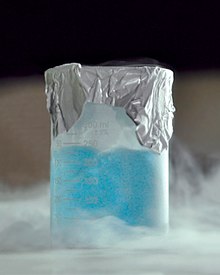Liquid oxygen


Liquid oxygen,sometimes abbreviated asLOXorLOXygen,is a clear light sky-blueliquidform ofdioxygenO2.It was used as theoxidizerin the first liquid-fueled rocket invented in 1926 byRobert H. Goddard,[1]an application which has continued to the present.
Physical properties
[edit]Liquid oxygen has a clear light sky-blue color and is stronglyparamagnetic:it can be suspended between the poles of a powerfulhorseshoe magnet.[2]Liquid oxygen has a density of 1.141 kg/L (1.141 g/ml), slightly denser than liquid water, and iscryogenicwith a freezing point of 54.36 K (−218.79 °C; −361.82 °F) and a boiling point of 90.19 K (−182.96 °C; −297.33 °F) at 1 bar (15 psi). Liquid oxygen has anexpansion ratioof 1:861[3][4]and because of this, it is used in some commercial and military aircraft as a transportable source of breathing oxygen.
Because of its cryogenic nature, liquid oxygen can cause the materials it touches to become extremely brittle. Liquid oxygen is also a very powerful oxidizing agent: organic materials will burn rapidly and energetically in liquid oxygen. Further, ifsoaked in liquid oxygen,some materials such as coal briquettes,carbon black,etc., candetonateunpredictably from sources of ignition such as flames, sparks or impact from light blows.Petrochemicals,includingasphalt,often exhibit this behavior.[5]
Thetetraoxygenmolecule (O4) was first predicted in 1924 byGilbert N. Lewis,who proposed it to explain why liquid oxygen defiedCurie's law.[6]Modern computer simulations indicate that, although there are no stable O4molecules in liquid oxygen, O2molecules do tend to associate in pairs with antiparallelspins,forming transient O4units.[7]
Liquid nitrogenhas a lower boiling point at −196 °C (77 K) than oxygen's −183 °C (90 K), and vessels containing liquid nitrogen can condense oxygen from air: when most of the nitrogen has evaporated from such a vessel, there is a risk that liquid oxygen remaining can react violently with organic material. Conversely, liquid nitrogen orliquid aircan be oxygen-enriched by letting it stand in open air; atmospheric oxygen dissolves in it, while nitrogen evaporates preferentially.
The surface tension of liquid oxygen at its normal pressure boiling point is 13.2 dyn/cm.[8]
Uses
[edit]
In commerce, liquid oxygen is classified as anindustrial gasand is widely used for industrial and medical purposes. Liquid oxygen is obtained from theoxygenfound naturally inairbyfractional distillationin acryogenic air separation plant.

Air forces have long recognized the strategic importance of liquid oxygen, both as an oxidizer and as a supply of gaseous oxygen for breathing in hospitals and high-altitude aircraft flights. In 1985, the USAF started a program of building its own oxygen-generation facilities at all major consumption bases.[9][10]
In rocket propellant
[edit]
Liquid oxygen is the most commoncryogenicliquidoxidizerpropellant forspacecraft rocketapplications, usually in combination withliquid hydrogen,keroseneormethane.[11][12]
Liquid oxygen was used in thefirst liquid fueled rocket.TheWorld War IIV-2missile also used liquid oxygen under the nameA-StoffandSauerstoff.In the 1950s, during theCold Warboth the United States'RedstoneandAtlasrockets, and theSovietR-7 Semyorkaused liquid oxygen. Later, in the 1960s and 1970s, the ascent stages of theApollo Saturn rockets,and theSpace Shuttle main enginesused liquid oxygen.
As of 2024, many active rockets use liquid oxygen:
- Chinese space program:Long March 5,Long March 6,Long March 7,Long March 8
- European Space Agency:Ariane 6(under development)
- Indian Space Research Organisation:GSLV
- JAXA(Japan):H-IIA,H3
- Korea Aerospace Research Institute:Naro-1,Nuri
- Roscosmos(Russia):Soyuz-2,Angara
- United States
History
[edit]- By 1845,Michael Faradayhad managed to liquefy most gases then known to exist. Six gases, however, resisted every attempt at liquefaction[13]and were known at the time as "permanent gases". They were oxygen,hydrogen,nitrogen,carbon monoxide,methane,andnitric oxide.
- In 1877,Louis Paul Cailletetin France andRaoul Pictetin Switzerland succeeded in producing the first droplets of liquid air.[citation needed]
- In 1883, Polish professorsZygmunt WróblewskiandKarol Olszewskiproduced the first measurable quantity of liquid oxygen.[citation needed]
See also
[edit]References
[edit]- ^"First liquid-fueled rocket".HISTORY.Retrieved2019-03-16.
- ^Moore, John W.; Stanitski, Conrad L.; Jurs, Peter C. (21 January 2009).Principles of Chemistry: The Molecular Science.Cengage Learning. pp. 297–.ISBN978-0-495-39079-4.Retrieved3 April2011.
- ^Cryogenic Safety.chemistry.ohio-state.edu.
- ^Characteristics.Archived2012-02-18 at theWayback Machine.Lindecanada. Retrieved on 2012-07-22.
- ^"Liquid Oxygen Receipt, Handling, Storage and Disposal".USAF Training Film.
- ^Lewis, Gilbert N.(1924). "The Magnetism of Oxygen and the Molecule O2".Journal of the American Chemical Society.46(9): 2027–2032.doi:10.1021/ja01674a008.
- ^Oda, Tatsuki; Alfredo Pasquarello (2004)."Noncollinear magnetism in liquid oxygen: A first-principles molecular dynamics study".Physical Review B.70(134402): 1–19.Bibcode:2004PhRvB..70m4402O.doi:10.1103/PhysRevB.70.134402.hdl:2297/3462.S2CID123535786.
- ^J. M. Jurns and J. W. Hartwig (2011).Liquid Oxygen Liquid Acquisition Device Bubble Point Tests With High Pressure LOX at Elevated Temperatures,p. 4.
- ^Arnold, Mark.1U.S. Army Oxygen Generation System Development.RTO-MP-HFM-182. dtic.mil
- ^Timmerhaus, K. D. (8 March 2013).Advances in Cryogenic Engineering: Proceedings of the 1957 Cryogenic Engineering Conference, National Bureau of Standards Boulder, Colorado, August 19–21, 1957.Springer Science & Business Media. pp. 150–.ISBN978-1-4684-3105-6.
- ^Belluscio, Alejandro G. (March 7, 2014)."SpaceX advances drive for Mars rocket via Raptor power".NASAspaceflight.RetrievedMarch 13,2014.
- ^Todd, David (November 20, 2012)."Musk goes for methane-burning reusable rockets as step to colonise Mars".FlightGlobal Hyperbola.Archived fromthe originalon November 28, 2012.RetrievedNovember 22,2012.
'We are going to do methane,' Musk announced as he described his future plans for reusable launch vehicles including those designed to take astronauts to Mars within 15 years, 'The energy cost of methane is the lowest and it has a slight Isp (Specific Impulse) advantage over Kerosene' said Musk adding, 'and it does not have the pain in the ass factor that hydrogen has.'... SpaceX's initial plan will be to build a lox/methane rocket for a future upper stage codenamed Raptor.... The new Raptor upper stage engine is likely to be only the first engine in a series of lox/methane engines.
- ^Cryogenics.Scienceclarified. Retrieved on 2012-07-22.
